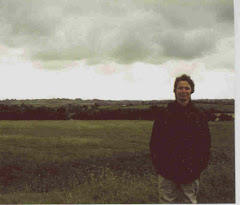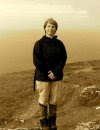Following Kafka through a dark and twisting wood

Often when I am creating a course, I become immersed in the author and his or her world. When I created the Lanscape and Lit course, I was working with writers in British Romanticism, which was rather pleasant be use there is a sentimentality that is an idealistic enjoyment of beauty even if it will eventually decay. Creating a course on Gothic lit includes horror and surreal struggles with repression. Kafka's invocation of the horror of paralysis, the void of identity crisis and the capricious power of invisible oppressors is, well, oppressive. I went to the park where he would walk and sat on a lovely hillside covered with cherry trees. I read that this is where he would sit and brood on the meaning of life. As a Lady of a Certain Age, this just seems silly, and I would have given him a swift kick and told him to quit being such a whiner. Check it out man: this is a hillside of cherry trees overlooking a beautiful city. You really have to be dedicated to being unhappy to be so here. But then I guess that's where his literature came from.

Actually, the absurdity of the surrealism in The Castle is funny, so. I guess that is the final escape hatch. If you laugh at how ridiculous the horror is, then it loses some of it's power. There is huge Hollywood style sculpture on the hillside, visible from any point that has a northern river view, that is a huge metronome and tall white letters that spell out "the tears of Lenin.". It is in the place where they blew up a statue of Stalin in 1962.

I checked out the local mass at the cathedral of Our Lady, which sits on the north side of the square. It was in Czech, but the plainsong was in Latin, so the music was quite nice. When the sun came out the whole place glowed with light as it came in the high windows and reflected off the white washed walls and the gilded statues. But then the sun went in and the full weight of a cold grey Gothic Catholicism fell on the space like a big Wile E. Coyote anvil. I was glad I kept my coat on because it got cold. It was during communion that I had an. Interesting insight about the Self Regulated Learning/Experiential Learning cycle.
In this Learning Cycle, one experiences something, makes a mistake, figures out what the right thing is, and then gets to try again with trying not to make the mistake. Well, in our classes, we don't always let students finish by trying again. They take a test, or write a paper, and that's it. The errors are pointed out and we move on. This is terribly counter productive. It is important to try again on The Same Thing in order to learn. S what lead me to this is here I am in a Czech mass, and I'm standing up and sitting down with everyone. I go up for communion, and I'm telling you, Gentle Reader, this has always worked before. I know there are variations, so I watch the guy in front of me, and I did what he did: took the wafer in my hand, and turned to leave. "Hissst," goes the priest. I think to myself, dart, I should have gone to the right to the little acolyte. I had forgotten to stay and be blessed.
A more successful interaction was when I was hiking up the hill with the other middle-aged ladies out Doing Business, a woman came up to me and said a rapid sentence in Czech. I understood two words, and they were both street names. I guessed that she was asking for directions, and I repeated the street name I recognized, Narodni. Ano, she said, and then called something to her friend that I guessed was, "Hey, she's got a map!". I showed this person the map and pointed to Narodni Street. Ze? She said pointing down the street. Ano, I said, Ze. I think this meant something like, yes, that way. I recognized the work Djekui as thank you, and I just smiled and waved because I do not yet have the Czech for, you're welcome, in my brain. Nonetheless, that worked out well.
Alas my next attempt at interaction with the grocery store clerk went less well. Grocery stores cause me great anxiety because I was yelled at once in a Swiss grocery store because I did not weigh my apples and mark them before I got to the register. This negative feedback on my lack of grocery cultural competence taught me to do a great deal of observation before getting to the register. I had already observed that you do not get your change in your hand. Instead you let the change be put into a little indentation on the counter and then pick it up, unless it is at a street cart where there is not a cup. Anyway, I got my stuff, and spent a few minutes watching people check out. I noticed that the checkout lady didn't like to make change as well. I also noticed that she weighed the stuff herself, so I didn't need to weigh anything myself. I had read that I needed my own bag, and I had that. With all my planning ready, I prepared to effect my grocery buying plan.
I put my stuff on the belt, and she ran it all through. She said a long sentence to me that started with Dobry Den and I think that she wanted to know if I had a Tesco savings card. unprepared for that, I was silent, but I should have said Dobry Den back. I'll try that next time. She then pushed all my stuff through and took out a plastic bag for my stuff! Neh, I said and held up my bag. She put the bag away and let me bag my stuff. That seemed okay. Then came the exchange of cash. It was 171 koruna. I pulled out a 100 note,and started to fish for change, since I thought this is her preference. It was, but I was too slow. She leaned over and took the right change out of my hand. It happened really fast! I was sad I was so slow. The numbers came up quickly, I wasn't wearing glasses, and I had to read each coin. *sigh*. Next time, I will be better aware of my coins, and I will greet properly. Was it instrumentally successful? Yes. I got my groceries. Was it socially successful? No. I look forward to the day when I have an service interaction with a Czech person where I do not annoy that person. in front of the priest. I go back, he makes the sign of the cross on my forehead.....and takes my wafer! I went back to my seat and watched everybody else. They did what I had done. I have no idea what I did wrong. If I were to learn what was right, then I would have to go back a few times and try again, but I failed this test, and in this case, I don't get to try again. So I reflected that a) I'll never know and b) there is great benefit for students to do an assessment multiple times if we hope for any of the learning to stick. Newsflash: midterm and final are not enough.
But back to the Castle. Even though Critics agree that Hradcany Castle isn't necessarily The castle, but it is for this reader. There it is up on the hill, and I haven't managed to get to it yet. I will, since St Vitus up there is a special Gothic masterpiece, and there is a little Kafka museum up there too, but I'm waiting for Debbie to arrive to visit the castle. Nevertheless, there I am, after a very disappointing visit to the Strahov Monastery, standing just outside the gates in the pouring rain, hiding under a tree, and not going in because now is not the right time. I laughed at myself as my feet got wetter and wetter. Absurdity and Surrealism have a Venn diagram relationship.
And now for a moment of complaint: the Strahov Monastery library is quite beautiful, from a bibliophilic point of view, but it is a Dickensian experience. You know when the ragged urchin presses his nose against the window of the toy/candy shop but knows nothing can come of it? Well, bibliophiles have to press their metaphorical noses up against a velvet rope that goes across a three foot door with an eagle eyed guard who pounces on anyone producing a camera. It reminded me of trying to view the Mona Lisa at the Louvre behind that scratched, spit slimed piece of plexiglass. In this case, the pictures on the internet are better because the bitterness of disappointment is much less.
But my lessons in turning oppression to humor came to my rescue because this guard who gets to spend all day looking at this beautiful library never gets to see it because she is too busy guarding it. I laughed all the way down the stairs.
So then I go down to the Kafka Museum, which is on the New Town side of the river, quite near the Charles Bridge. It has a big K in front of it as one sculpture, and then there is a fountain of two bronze men holding their rather prominent winkies and urinating at each other into the fountain. Their pelvises are on swivels so they spray their wee around the fountain. There is no text to go with this sculpture, so one must make up one's own text. We are, once more, standing at the Venn intersection of the absurd and the surreal. I don't think one could give this sculpture any text. Mothers take pictures of their children with these sculptures. People put their hands into the fountain spray. I was transfixed not just by the sculpture, but also with the public interaction with it. I guess it is making the private so surprisingly public that it strips away the observers' inhibitions. That little guy in Brussels has Nothing on these guys.
On a final technical note, I interviewed hostels today. The Dlouha Travelers Hostel is dirty, noisy, free, and near the edge of the main old town square. The Downtown Hostel is spic and span, quiet, tightly controlled, and a longer walk from the central old town square. The Ritchie Hostel is right in between those two extremes.









































